Hailstorms can wreak havoc on your car, leaving behind unsightly dents and damage. If you’re a car owner in Houston, you’re probably no stranger to the damage hail can cause. Fortunately, Paintless Dent Repair (PDR) offers an efficient, cost-effective solution to restore your car to its pre-storm condition. This comprehensive guide will explore everything you need to know about hail damage repair in Houston, focusing on the paintless dent repair method.
What is Hail Damage Repair?
Hail damage repair refers to the process of fixing dents, dings, and other forms of damage caused by hailstorms. These types of damage can range from minor, shallow dents to severe creases and broken paint. Hail damage can seriously affect the appearance and value of your vehicle if not addressed quickly.
Types of Hail Damage
Minor Dents
Minor dents are small, usually shallow, and don’t break the vehicle’s paint. These are common in lighter hailstorms and are the easiest to fix using PDR methods.
Severe Dents and Creases
Severe dents are deeper and larger, often leaving visible creases. They require more expertise and advanced PDR tools to repair.
Paint Damage
In some cases, hail can crack or chip your car’s paint. While PDR can fix the dent itself, paint damage may require additional touch-up or repainting, depending on the severity.
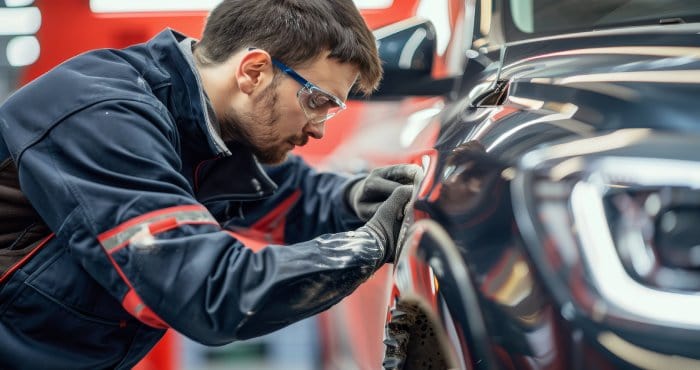
How Hail Damage Affects Your Car
Hail damage isn’t just cosmetic. Over time, it can worsen and lead to rust if the paint is compromised. Furthermore, the resale value of your vehicle may plummet if hail damage isn’t repaired promptly. In Houston’s humid climate, untreated hail damage can lead to quicker deterioration.
Understanding Paintless Dent Repair (PDR)
Paintless Dent Repair (PDR) is a non-invasive technique used to remove dents from the surface of a car without damaging the original paint. It’s the preferred method for hail damage repair in Houston due to its efficiency and cost-effectiveness.
What is Paintless Dent Repair?
PDR involves using specialized tools to gently massage the dented metal back into its original shape. Unlike traditional methods that require fillers and repainting, PDR maintains the car’s factory paint finish.
How PDR Works for Hail Damage
PDR is ideal for hail damage because most hail dents don’t affect the paint. Here’s how it works:
Evaluating the Damage
Before starting the repair, a technician inspects the extent of the hail damage to determine if PDR is suitable.
Using Special Tools for PDR
Technicians use metal rods, hammers, and other tools to slowly push the dents out from the underside of the car’s body panel.
Benefits of PDR over Traditional Methods
Compared to conventional repair methods that involve sanding and repainting, PDR is faster, less expensive, and preserves the car’s original paint.
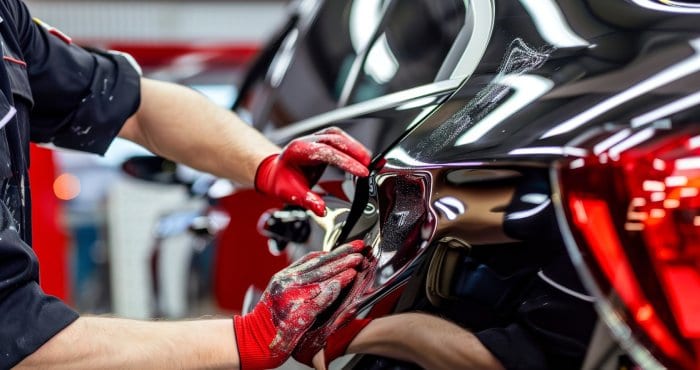
Benefits of Paintless Dent Repair for Hail Damage in Houston
Why choose PDR for hail damage repair? There are several reasons this method has become the go-to for Houston drivers.
Cost-Effectiveness
PDR is often more affordable than traditional dent repair because it doesn’t require new paint or body fillers. You save money on materials and labor.
Faster Repair Times
PDR is a quicker process compared to conventional repairs. Many dents can be fixed in just a few hours, allowing you to get back on the road faster.
Retaining the Original Paint
One of the most significant benefits of PDR is that it retains your vehicle’s original paint, which helps maintain its resale value.
Avoiding Repainting Costs
Since PDR doesn’t involve repainting, you avoid the additional costs associated with matching and applying new paint.
Preserving Vehicle Value
A car with its factory paint intact is worth more than one that has been repainted. PDR helps keep your car’s value high.
The Paintless Dent Repair Process for Hail Damage in Houston
Curious about what happens when you take your car in for hail damage repair using PDR? Here’s a breakdown of the process:
Inspection and Assessment
The technician starts by inspecting the vehicle to assess the severity of the damage and determine if PDR is the best option.
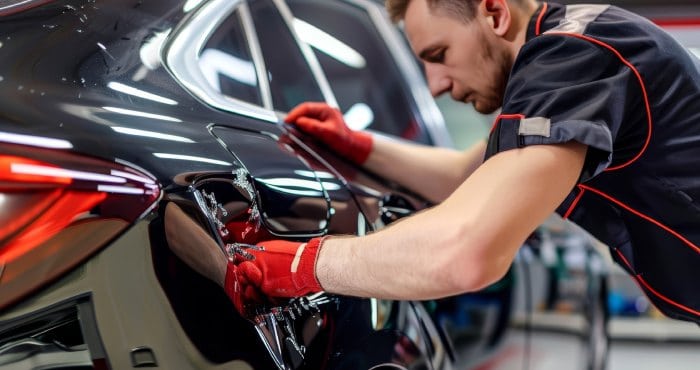
Dent Removal Using PDR Techniques
Technicians use a variety of tools and techniques to remove dents:
- Gentle Pushing Techniques
From the inside of the panel, the technician gently pushes the metal back into shape.
- Advanced Suction Methods
For more difficult dents, suction cups and pulling devices may be used.
- Quality Check and Finalizing the Repair
After the dents are removed, the technician will thoroughly inspect the vehicle to ensure that no damage remains.
- Tools and Techniques Used in Hail Damage Repair
PDR requires a unique set of tools and techniques that differ from traditional auto body repair.
- Specialized PDR Tools
Technicians use various tools specifically designed for PDR:
- Dent Lifter Tools
These are used to lift and reshape the metal back to its original form.
- PDR Rods and Hammers
Rods of different shapes and sizes allow technicians to push out dents from the inside of the panel.
- Glue Pulling Techniques
For hard-to-reach areas, glue tabs are applied to the surface of the dent and pulled outward to remove it.
- Mastering the Art of Paintless Dent Repair
PDR requires skill and precision. Technicians train for years to master the craft, ensuring the highest quality of repair without damaging the paint.
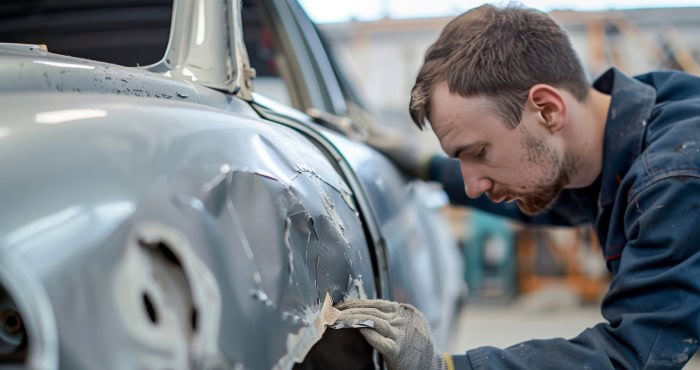
Common Types of Damage Repaired by PDR
PDR is highly versatile and can fix various types of damage:
Hail Dents
Small, round dents caused by hailstorms are the most common type of damage repaired by PDR.
Parking Lot Dents
PDR can also be used to fix dents caused by other car doors, shopping carts, or minor accidents.
Creases and Dings
Even more complicated damage like creases or sharp dings can be repaired using PDR.
Cost of Hail Damage Repair in Houston
What can you expect to pay for hail damage repair in Houston?
Factors Affecting the Cost
The cost of hail damage repair depends on several factors:
Severity of Damage
The more severe the dents, the higher the cost of repair. Larger or deeper dents may require more time and expertise.
Type of Vehicle
Luxury or specialty vehicles may have more expensive repairs due to the complexity of their body panels.
Comparing PDR Costs to Traditional Repair Methods
Traditional repairs, which involve filling and repainting, can be double or triple the cost of PDR. PDR is generally the more affordable option.
How to Choose the Right Hail Damage Repair Shop in Houston
With so many options, how do you pick the right shop for hail damage repair?
Check for Certifications
Ensure the shop is certified in Paintless Dent Repair and has experience with hail damage specifically.
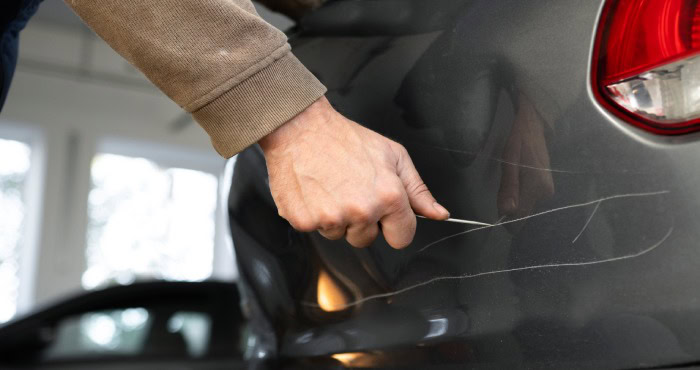
Read Customer Reviews and Testimonials
Online reviews and testimonials provide insight into the shop’s reputation and the quality of its work.
Importance of Experience in PDR for Hail Damage
PDR is a skill that takes time to master. Look for a shop with experienced technicians who specialize in hail damage repair.
Preventing Future Hail Damage
While you can’t control Houston’s weather, there are steps you can take to minimize future hail damage:
Parking in Covered Areas
Whenever possible, park in garages or covered areas during hailstorms.
Investing in Hail Protection Covers
Car covers designed for hail protection can help reduce the damage during a storm.
Monitoring Houston Weather Patterns
Stay aware of upcoming storms by following weather reports, and take proactive steps to protect your vehicle.
Frequently Asked Questions (FAQs) About Hail Damage Repair in Houston
What is the Best Time to Repair Hail Damage?
It’s best to repair hail damage as soon as possible to prevent further damage and rust.
Can Hail Damage Repair Be Covered by Insurance?
Yes, most comprehensive auto insurance policies cover hail damage repair.
How Long Does the PDR Process Take for Hail Damage?
Depending on the severity of the damage, PDR can take anywhere from a few hours to a couple of days.
Conclusion
Hail damage is an unfortunate reality for car owners in Houston, but Paintless Dent Repair offers an effective and affordable solution. By choosing PDR, you can quickly restore your car to its former glory without the need for costly and time-consuming traditional repairs. The key is to act fast, choose the right repair shop, and take steps to prevent future damage. Now that you know the ins and outs of hail damage repair in Houston, you’re better equipped to make informed decisions about your vehicle.
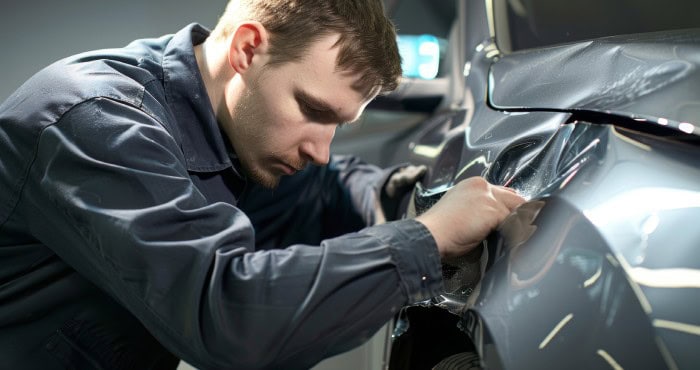
FAQs
- How much does hail damage repair cost in Houston?
The cost varies depending on the severity of the damage but is typically more affordable with PDR than traditional methods.
- Is PDR suitable for all hail damage?
PDR works best for minor dents where the paint is not damaged, but severe cases may require traditional repair methods.
- Can I drive with hail damage?
While it may be safe to drive, it’s not recommended as hail damage can worsen over time and lead to rust.
- How do I know if my car is a candidate for PDR?
A technician will assess the damage to determine if PDR is the right option for your vehicle.
- What should I look for in a hail damage repair shop?
Look for experience, certifications, and positive customer reviews when choosing a repair shop for hail damage.
